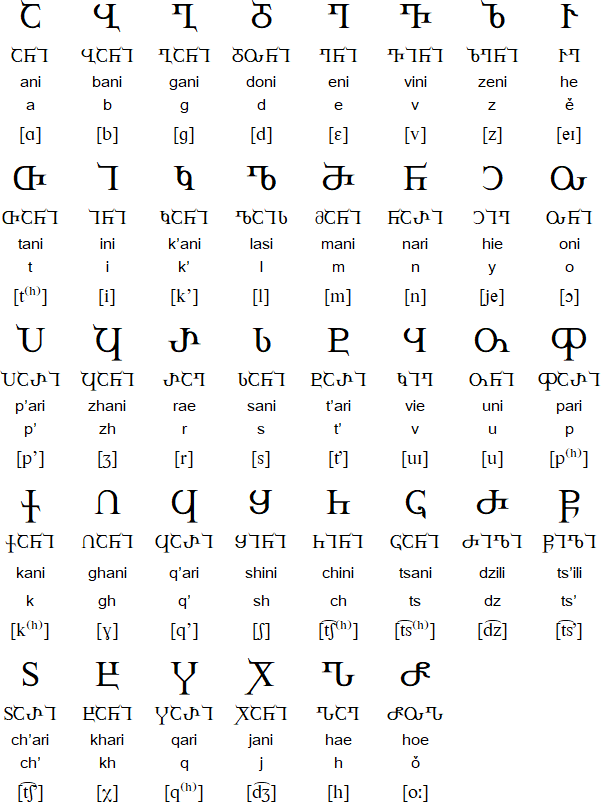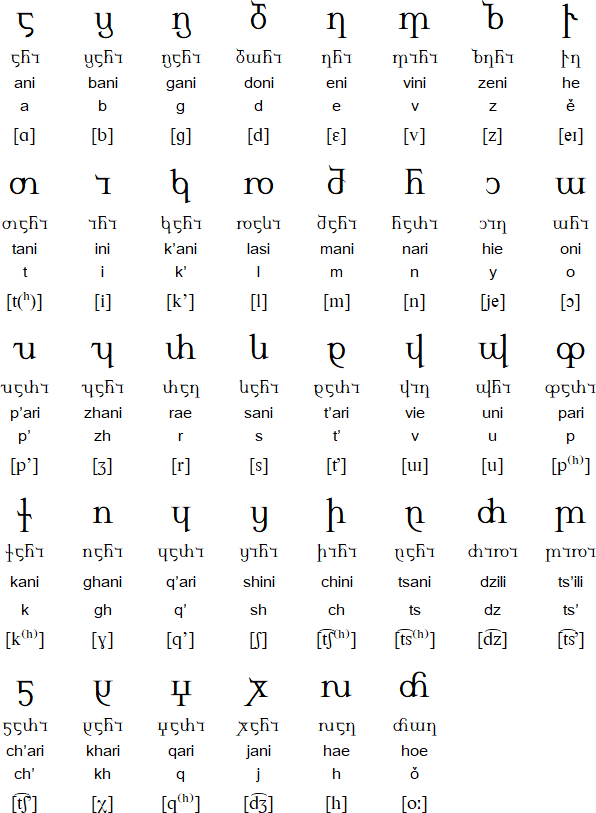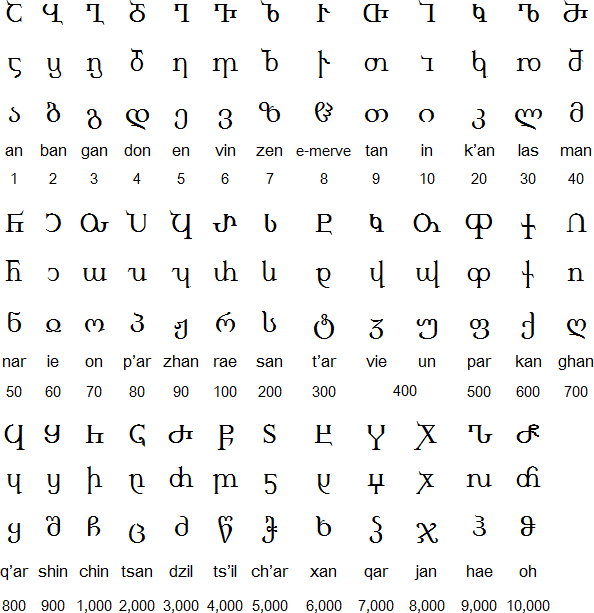Georgian (ႵႠႰႧႳႪႨ ႤႬႠ / ⴕⴀⴐⴇⴓⴊⴈ ⴄⴌⴀ / ქართული ენა)
Georgian is a South Caucasian or Kartvelian language spoken
by about 4.1 million people mainly in Georgia, and also in Russia,
Ukraine, Turkey, Azerbaijan, Iran, Abkhazia and South Ossetia.
Georgian is related to Mingrelian
(მარგალური ნინა),
Laz (ლაზური ნენა),
and Svan (ლუშნუ ნინ),
all of which are spoken mainly in Georgia and are written with the
Georgian (Mkhedruli) alphabet.
Georgian is thought to share a common ancestral language with
the other South Caucasian languages. Svan is believed to have split
from this language during the 2nd millenium BC, and the other languages
split up around 1,000 years later.
Written Georgian
The Georgian language first appeared in writing in about 430 AD in an
inscription in a church in Palestine in an alphabet known as
Asomtavruli. Before then the main
written language used in Georgia was a form of Aramaic known as Armazuli
(არმაზული დამწერლობა).
Two other alphabets have been used to write Georgian:
Nushkhuri and Mkhedruli,
which is the alphabet currently used.
Asomtavruli (ႠႱႭႫႧႠႥႰႳႺႠ)
The Georgian language first appeared in writing in about 430 AD in an
inscription in a church in Palestine. At that time it was written with
an alphabet known as Asomtavruli (ႠႱႭႫႧႠႥႰႳႺႠ
– “capital letters”) or Mrglovani (ႫႰႢႥႪႭႥႠႬႨ
– “rounded”), which was used until the 9th century. Asomtavruli was
probably modelled on the Greek
alphabet, though nobody knows who was responsible for this. Armenian
scholars believe that Mesrop Mashtots’, an Armenian missionary,
created Asomtavruli, while Georgian scholars believe that King
Farnavaz of Georgia did so.

Nuskhuri (ⴌⴓⴑⴞⴓⴐⴈ)
During the 9th century, Asomtavruli was gradually replaced by
a more angular alphabet known as Nuskhuri (“minuscule, lowercase”),
which was used until the 11th century.

Mkhedruli (მხედრული)
The Mkhedruli alphabet developed from Nuskhuri
between the 11th and 13th centuries. The name Mkhedruli comes from the
word mkhedari which means ‘of horseman’.
At first Mkhedruli was used only for secular writing, while for religious
writings a mixture of the two older alphabets was used. Eventually
Nuskhuri became the main alphabet for religious texts and
Asomtavruli was used only for titles and for the first letters of
sentences. This system of mixing the two alphabets was known as khucesi
(priest) writing.
Eventually the two older alphabets fell out of use and Mkhedruli
became the sole alphabet used to write Georgian. However, in the writings
of a linguist called Akaki Shanidze (1887-1987) and in works written
in his honour, letters from the Asomtavruli
alphabet are used to mark proper names and the beginning of sentences.
Shanidze’s attempt to popularise such usage met with little success.
The first printed material in the Mkhedruli language, a Georgian-Italian dictionary,
was published in 1629 in Rome. Since then the alphabet has changed
very little, though a few letters were added by Anton I in the 18th
century, and 5 letters were dropped in the 1860s when Ilia Chavchavadze
introduced a number of reforms.
Mkhedruli alphabet (მხედრული)

Notes
- The letters in red are no longer used.
- The names of the letters in the Georgian alphabet are the formal, traditional names.
The letters names in the IPA are the usual way to refer to them. - The letters used to have the numerical values shown.
Georgian pronunciation

Information about the Georgian alphabet from Konstantin Gugeshashvili
Chart showing the three Georgian alphabets together
The top row of letters on each line is in the Asomtavruli alphabet,
the second row is in the Nuskhuri alphabet, and third row is in the
Mkhedruli alphabet.

Downloads
Download a Georgian alphabet charts in Excel,
Word
or PDF format
Sample text in Georgian in the Asomtavruli alphabet

Sample text in Georgian in the Nuskhuri alphabet

Sample text in Georgian in the Mkhedruli alphabet

Transliteration
Qvela adamiani ibadeba tavisupali da tanasts’ori tavisi ghirsebita da uplebebit. Mat
minich’ebuli akvt goneba da sindisi da ertmanetis mimart unda iktseodnen dzmobis
sulisk’vetebit.
A recording of this text by George Keretchashvili
Translation
All human beings are born free and equal in dignity and rights. They
are endowed with reason and conscience and should act towards one another
in a spirit of brotherhood.
(Article 1 of the Universal Declaration of Human Rights)
